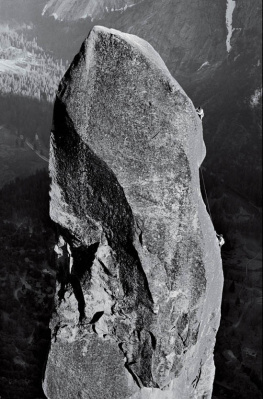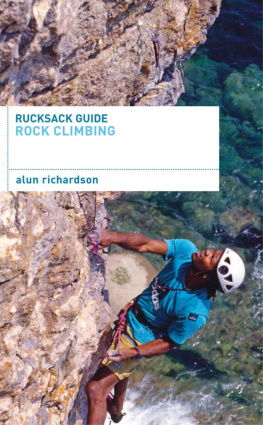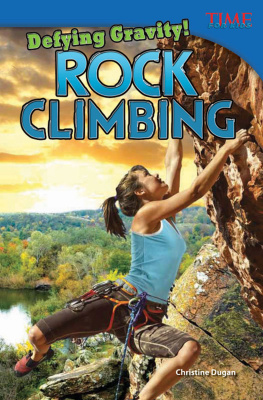Yvon Chouinard sorting out. 1969.*
Here we see the full range of pitons made by Chouinard, from tiny RURPS to huge bong-bongs. These were the finely crafted tools that enabled climbers to master Yosemites big walls during the 1960s. Notice that a few nuts have joined the pitons. This was a few years before clean climbing started to take over.
TABLE OF CONTENTS
PREFACE
We all dreamed as kids about finding buried treasure. These photos, which arrived in the mail and out of the blue, are better than buried treasure for those of us who knew Yosemite in the sixties. This rich time had left a thin historical record: as conquistadors of the useless my friends and I gave little thought to anything as abstract as the future.
So you can imagine what we felt like when we spread a hundred or so of these shots across a big table. To see these photos for the first time is to discover the big-wall eras equivalent of the Rosetta stone or the Dead Sea scrolls. Glen Denny had the artists eye for a face (a rock wall or a human being) and need to get the moment across. These photos deepen our visual record of the climbs. They also make a new kind of history because they recover a Camp 4 life that didnt get otherwise photographed; at least not by anyone as talented as Glen, whose eye was as sharp for the culture as for the climbs.
Like Steve Roper, whose essay appears in this book, I was formed by those climbs and by that culture. What I learned in Yosemite to rely on myself and my partners and common sense to stay alive, how to take risks and even more, how to manage them became the principles I used to found Patagonia, Inc. Today these lessons are still the bedrock of our corporate culture.
So when we saw these photographs, our response was to do what we could to get them published as a book. We called our friend Tom Adler, who had published several celebrated photography books of the early history of surfing in America. Toms aesthetic as a book designer perfectly matches Glens eyes as a photographer.
Our company has always been about giving back helping to preserve what wildness remains on our planet. Now it gives us satisfaction to give back to the history of the sport that taught us a new way to run a business and what we are convinced is the proper way to live our lives.
Yvon Chouinard
TO THE DENIZENS OF CAMP 4
Yosemite Valley from Tunnel View, with an afternoon thunderstorm approaching from the high country. The great rocks of the Valley, from left to right: El Capitan, Clouds Rest in the far distance, Half Dome, Sentinel Rock, the three Cathedral Rocks with Bridalveil Fall beneath them, and the Leaning Tower.
Clearing storm clouds on Cathedral Rocks. Taken from Camp 6 in the evening of our third day on the Nose of El Capitan, during the third ascent in 1963.
Charlie Raymond leading Moby Dick, a classic short climb at the base of El Capitan. The Heart, a prominent feature on the southwest face of El Cap, is at the left.
Camp 4. Sorting hardware for the third ascent of the Nose route on El Capitan. At the table (left to right): Beverly Powell Woolsey, Mark Powell, Mike Borghoff, Dorothy Bird Borghoff, Steve Roper. At the car: Chris Fredericks (left) and Layton Kor.
Warren Hardings hands, after 27 days on the Dawn Wall.
Warren Harding on the last pitch of the Dawn Wall, El Capitan, during the first ascent in 1970.
CALIFORNIA AND CAMP 4
Kevin Starr
In 1997, Camp 4 was threatened with destruction to make way for expansion of Yosemite Lodge. It failed to win a reprieve when the National Park Service historian assigned to assess its potential for preservation determined that it lacked the requisite historical significance or esthetic integrity. Yet ten years later, Camp 4 remains a living, thriving center of the rock-climbing tradition, the spiritual home of thousands of climbers from around the world who visit every year. Its future was secured by its addition to the National Register of Historic Places in 2003 as a result of the combined efforts of the local and international climbing community, authors of mountaineering literature, and the American Alpine Club. I am happy that, as a historian and California state librarian, I was able to contribute to this campaign my perspective on the importance of Camp 4 in Californias cultural history.
What galvanized the coalition to save Camp 4? To outsiders, its charms are modest and its structures utilitarian. But insiders know that, particularly in the so-called Golden Age of Yosemite climbing, Camp 4s residents developed the techniques, tools, and philosophies that made the Valley the most important rock-climbing arena in the world. It also was the seedbed for a new entrepreneurial approach, as characterized by Yvon Chouinard and others, that combined craftsmanship, social values, and environmental activism. Steve Roper, in his book Camp 4, captured the essence of that era; and this volume of photographs by Glen Denny provides the visual counterpart to Ropers book.
Yet the cultural and historical significance of Camp 4 goes far deeper: it is important not only for the spectacular feats accomplished on El Capitan and the other great Valley walls but also as a locus for the whole span of mountaineering history of California. Through it we can sense the reverberations of generations of California mountaineers, from Clarence King and John Muir to David Brower and John Salath to the Golden Age figures depicted in this book, including Royal Robbins, Warren Harding, and Chuck Pratt and then on to the current generation of Camp 4 climbers, who continue to redefine the limits of possibility. Here is a place where the culture of California in terms of its relationship to nature was consolidated and intensified. Over the years, the mountaineers based in Camp 4 probed physically, intellectually, imaginatively, and as a matter of heroic action a fundamental premise of California as a society and a civilization: namely, that the mountains challenge us to encounter them so that we might become our best possible selves.
Please note: Asterisk (*) indicates extended caption in back of book. Previous spreads: (PP. 6-7) Yosemite Valley. 1964,* (PP. 8-9) Cathedral Rocks. 1963,* (PP. 10-11) Climbing Moby Dick. 1965,* (PP. 12-13) Hardware sortout in Camp 4. 1963,* (PP. 14-15) Royal Robbins on the North America Wall. 1964, (PP. 16-17) Climbers hands. 1970,* (PP. 18-19) Warren Harding. 1970*.















